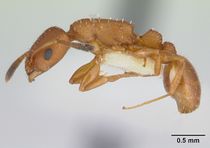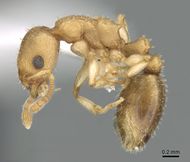Key to Afrotropical Nesomyrmex angulatus group workers
You may also be interested in
- Nesomyrmex
- Key to Nesomyrmex species groups of the Afrotropical region
- Diagnosis of Nesomyrmex species groups of the Afrotropical and Malagasy regions
1
- In profile mesosomal dorsum forming a single, uninterrupted flat surface without any trace of metanotal groove; petiolar peduncle short (Fig. 8A) . . . . . 2
- In profile mesosomal dorsum always with conspicuously impressed metanotal groove; petiolar peduncle long (Fig. 8B) . . . . . 3
2
return to couplet #1
- Body colour yellow to very light brown (Fig. 9A) . . . . . Nesomyrmex angulatus
- Body colour very dark brown to black (Fig. 9B) . . . . . Nesomyrmex grisoni
3
return to couplet #1
- First gastral tergite lacking standing hairs except for single transverse row on posterior end of tergite (Fig. 10A) . . . . . Nesomyrmex evelynae
- First gastral tergite with standing hairs evenly distributed throughout (Fig. 10B) . . . . . 4
4
return to couplet #3
- Antennal scapes conspicuously longer (SI 95–98); in dorsal view sides of petiolar node straight to weakly rounded, not laterally denticulate (Fig. 11A); dorsum of propodeum without standing hairs (Fig. 11B) . . . . . Nesomyrmex inhaca
- Antennal scapes conspicuously shorter (SI 67–77); in dorsal view petiolar node laterally denticulate (Fig. 11C); dorsum of propodeum with short standing hairs (Fig. 11D) . . . . . 5
5
return to couplet #4
- Eyes larger, with 10–12 ommatidia in longest row (Fig. 12A); subpetiolar process with a conspicuous tooth anteriorly, followed by a long cuticular flange running back to the postpetiolar junction (Fig. 12A) . . . . . Nesomyrmex denticulatus
- Eyes smaller, with 7–9 ommatidia in longest row (Fig. 12B); subpetiolar process with or without a conspicuously developed tooth anteriorly, but without a long cuticular flange running back to the postpetiolar junction (Fig. 12B) . . . . . 6
6
return to couplet #5
- Propodeal spines shorter and thicker, elongate-triangular and only weakly longer than their basal width; in profile petiolar node nodiform, appearing approximately as long as high (Fig. 13A) . . . . . Nesomyrmex innocens
- Propodeal spines longer and thinner, several times longer than their basal width; in profile petiolar node high, rectangular nodiform, appearing around twice as high as long (Fig. 13B) . . . . . Nesomyrmex stramineus



















